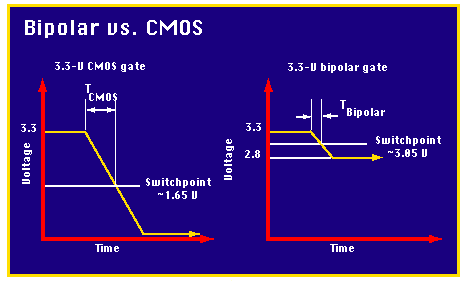| In a bid to create the world's fastest microprocessor, a
Silicon Valley start-up company is developing a PowerPC
chip that combines fast-switching bipolar transistors with
conventional CMOS technology. If the hybrid CPU lives up
to expectations, it could exceed 500 MHz and deliver three
times the performance of today's fastest Pentiums. The still-unnamed chip will be the first product from Exponential Technology (San Jose, CA). Founded in 1993, Exponential has a team of engineers and executives who formerly worked at Amdahl, Apple, Chips & Technologies, Intel, Mips Technologies, Motorola, National Semiconductor, and Sun Microsystems. Its initial chip design taped out in January, and first silicon samples should be available for testing this month. If the project continues on schedule, a second-pass design will tape out this summer and the chip will enter production early next year. Exponential is keeping relatively quiet about this processor, but the available information indicates it will be a radical design. Almost all the logic — roughly 40 percent of the chip's circuitry — consists of bipolar transistors, which can switch states much faster than regular CMOS transistors (see the figure). The remaining 60 percent of the circuitry is static RAM (SRAM) in the on-board caches. The die measures a mere 150 square millimeters. By modern standards, the chip's primary caches are puny: only 2 KB each for instructions and data. There's also a 32-KB secondary cache on-chip. The only other processor with a similar cache arrangement is Digital Equipment's Alpha 21164, which also runs at extremely high speeds (up to 400 MHz). However, the 21164 isn't bipolar. Intel's Pentiums use a BiCMOS process that combines bipolar and CMOS, but Intel uses the bipolar elements sparingly. Also, the Pentium's bipolar transistors don't achieve their potential speed because they're added to the primary CMOS layers. Exponential, in contrast, is starting with a bipolar process and then adding the CMOS elements. Another company that is working on this technique is MicroUnity (Sunnyvale, CA), which is developing a more specialized processor for broadband communications (see "Chip Fashion," November 1995 BYTE). Exponential's chip will be compatible with the PowerPC 604 and is intended for high-end desktop systems and servers. The PowerPC 620 from IBM and Motorola was supposed to fill that role, but its performance has been disappointing. Bipolar Pros and ConsBIPOLAR
ADVANTAGESBipolar vs. CMOS Copyright 1994-1998 BYTE |